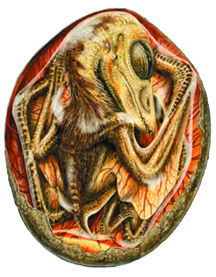 In the past decade,
some of the greatest fossil finds have emerged from the Liaoning province of
northeastern China. In the late 1990s, discoveries of tiny feathered dinosaurs
shook up the paleontological world and renewed debate on the origin of birds.
Now, researchers have uncovered another remarkable fossil from the prolific
Liaoning province — an unborn featherless flyer.
In the past decade,
some of the greatest fossil finds have emerged from the Liaoning province of
northeastern China. In the late 1990s, discoveries of tiny feathered dinosaurs
shook up the paleontological world and renewed debate on the origin of birds.
Now, researchers have uncovered another remarkable fossil from the prolific
Liaoning province — an unborn featherless flyer.Imprints of skin tissue and wing membranes, found within a fossilized pterosaur embryo, enable researchers to reconstruct what these ancient flying lizards looked like as they developed. Image courtesy Zhonghe Zhou.
In the June 10 Nature, Xiaolin Wang and Zhonghe Zhou of the Chinese Academy of Sciences in Beijing describe a new specimen of an extremely well-preserved pterosaur embryo, still enclosed in its eggshell, the first embryonic pterosaur ever recorded. Named from the Greek words meaning “flying lizard,” pterosaurs, which include pterodactyls, are the first vertebrates to have evolved self-powered flight. Pterosaurs do not have feathers and are not true dinosaurs, although they are suspected to share a close common ancestor with dinosaurs, Zhou says. The new research does highlight one trait dinosaurs and pterosaurs share — they both laid eggs.
“We expected pterosaurs would lay eggs, and this is a nice confirmation of that,” says Kevin Padian of the University of California, Berkeley. The 121-million-year-old fossil egg is about the size of a small chicken egg, although “the size of an egg doesn’t necessarily correlate to the size of the adult animal,” Padian says. “The animal just had to be large enough to pass the egg though its egg canal.”
The fossilized embryonic pterosaur is in the later stages of development and was “probably enjoying its last few days in the egg before hatching out,” the researchers reported. The well-developed features also suggest that pterosaurs were similar to some modern birds, such as chickens, ducks and turkeys. These animals “become independent of their parents soon after hatching out, therefore feeding and moving about by themselves,” Zhou says.
The details of the pterosaurs’ lives are only available because “the fossils are so well-preserved,” Padian says. “It gives us the ability to see features we can see nowhere else.” The Liaoning specimens were located in lake deposits that were periodically smothered by volcanic ash, preserving the fossils in fine detail. The depth and quality of this fossil resource will continue to make Liaoning a paleontology hot spot in the future.

